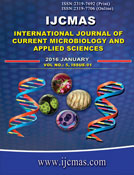


 National Academy of Agricultural Sciences (NAAS)
National Academy of Agricultural Sciences (NAAS)

|
PRINT ISSN : 2319-7692
Online ISSN : 2319-7706 Issues : 12 per year Publisher : Excellent Publishers Email : editorijcmas@gmail.com / submit@ijcmas.com Editor-in-chief: Dr.M.Prakash Index Copernicus ICV 2018: 95.39 NAAS RATING 2020: 5.38 |
Lebanese marine water is exposed to the major point sources of pollution, such as sewage outfalls, industrial wastewater effluents, costal agricultural runoffs, seafront dumps, and oil spills. Data on quality of Lebanese coastal waters is highly limited. The main objectives of this study was the quantification of 16 US EPA PAHs in the sea water in Tripoli Harbor , Lebanon one of the major harbors in the Middle East area. Twenty sea water samples were collected during January and February 20123, in accordance with the established norms and standards . Quantification using SPE and risk assessment of PAHs levels was evaluated to assess the possibility of occurrence of adverse health risk effects. Results showed that contamination with 16 US PAHs in water samples was observed all over the harbor with higher concentrations recorded at the near shore sites locations. Ratio of specific PAH compound including Phenantharene/Anthracene and Fluoranthene/Pyrene were calculated to evaluate the possible sources of PAHs contamination. These ratios reflect a petrogenic origin of PAHs in the studied water samples. The toxicity of the studied PAHs in Fish is the least compared. However, the most vulnerable and sensitive organisms in the study area are algae, followed by Daphnia.. Thus, these results necessitate the proposal of integrated intervention plans for the protection of Tripoli Harbour and that the pollution of the area must be cut back or stopped.
 |
 |
 |
 |
 |